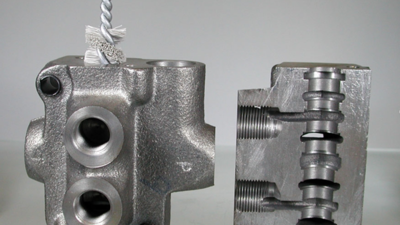
Deburring bores
Deburring bores is an important and difficult step in the machining process. In vehicle construction (e.g., engine and hydraulic parts), poor deburring may lead to severe damage or failure, thus posing high safety risks.
Deburring bores.
Deburring bores is an important and also difficult machining step. In vehicle manufacturing (e.g. engine and hydraulic parts), poor deburring can lead to severe damage or failure, which in turn poses a high safety risk.
Bore machining is complex.
Deburring bores is complex because it is not just the bore entrance and exit that must be deburred. Bores can also be combined with intersecting bores, stepped bores, or deep bores. They are often difficult to reach, and their diameters may be very small.
Bore machining is usually performed directly after the cutting process, and in the same machining center. In most cases, this involves the removal of a slightly adhering burr, combined with slight edge rounding.
Osborn's internal brushes, e.g., our Helituf® and Situft® products, which can be used for dry and wet applications, are best suited for this purpose. Our internal brushes self-center in the bore, eliminating the need for exact positioning and alignment of the workpiece or the brush. In addition to a clamping shank for toolholders with chucks (Weldon or Whistle Notch), we also offer cylindrical shanks for collets.

Application parameters matter.
The correct application parameters for the internal brush are decisive for the quality of the deburring result. It depends on the correct oversize of the brush to the bore, but also on how the brush is moved in and out of the bore. Our experts are at your disposal and will be happy to advise you!